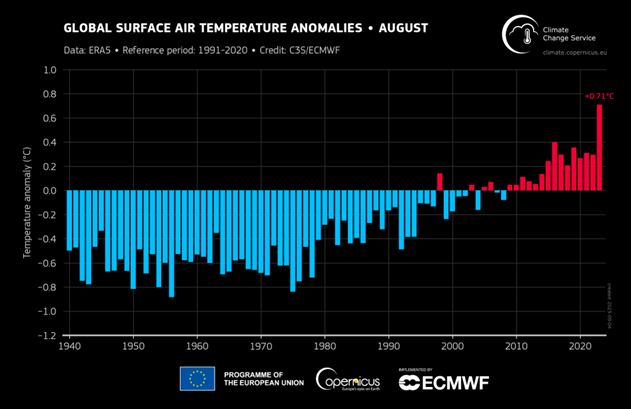
The Copernicus Climate Change Service (C3S), implemented by the European Center for Medium Range Weather Forecasts on behalf of the European Commission, routinely publishes monthly climate bulletins reporting on changes observed in the global surface air temperature, sea ice, and hydrological variables. All of the reported findings are based on computer-generated analyses using billions of measurements from satellites, ships, aircraft, and weather stations around the world.
Important events during June–July–August 2023:
- The June-July-August (JJA) season of 2023 was the warmest on record globally by a wide margin, with an average temperature of 16.77°C, 0.66°C above average.
- The European average temperature for the summer of 2023 was 19.63°C, which at 0.83°C above average was the fifth warmest summer season.
- June–July–August 2023 showed record high sea surface temperature (SST) anomalies in the North Atlantic and globally.
- The summer of 2023 experienced marine heat waves in several areas around Europe, such as around Ireland and the UK in June and in the Mediterranean in July and August.
- June–July–August 2023 saw above-average rainfall across most of Western Europe and Turkey, with local rainfall records leading to flooding. This was also the case in western and northeastern North America, parts of Asia, Chile and Brazil, and northwestern Australia.
- In contrast, Iceland, the Alps, northern Scandinavia, central Europe, much of Asia, Canada, southern North America, and most of South America experienced drier than average conditions. In some regions, this led to significant fires.
Surface air temperatures in August 2023:

Copernicus, Globally averaged surface air temperature anomalies relative to 1991–2020 for August from 1940 to 2023. Data: ERA5. Source: C3S / ECMWF.
- August 2023 was the warmest recorded August month globally, and warmer than all other months except July 2023.
- The global mean surface air temperature of 16.82°C for August 2023 was 0.71°C warmer than the 1991–2020 average for August and 0.31°C warmer than the previous warmest month of August 2016.
- August is estimated to have been about 1.5 degrees warmer than the pre-industrial average for 1850–1900.
- There were heat waves in several regions of the Northern Hemisphere, especially southern Europe, the southern United States and Japan.
- Well above average temperatures occurred in Australia, several South American countries and around large parts of Antarctica.
- Marine air temperatures were well above average in several other regions.
- The global temperature anomaly for the first 8 months of 2023 (January–August) ranks as the second warmest recorded, just 0.01°C over 2016, which holds the recorded record.
Samantha Burgess, Deputy Director of the Copernicus Climate Change Service (C3S), comments: “Global temperature records continue to be broken in 2023, with the warmest month of August following the warmest recorded months of July and June leading to the warmest Arctic summer in our record series dating back to 1940. 2023 currently ranks as the second warmest, only 0.01ºC behind 2016 with four months remaining in the year. Meanwhile, August saw the world’s oceans record both the warmest daily surface temperature on record and the warmest month on record. The scientific evidence is overwhelming – we will continue to see climate records and more intense and frequent extreme weather events affecting society and ecosystems until we stop emitting greenhouse gases.”
Sea surface temperatures in August 2023:

The daily global sea surface temperature (°C) averaged over the region 60°S–60°N plotted as a time series for each year from 1 January 1979 to 31 August 2023. The years 2023 and 2016 are shown with thick lines shaded in light red and dark red, respectively. Other years are shown with thin lines and shaded by decade, from blue (1970s/80s) to brick red (2020s). Data: ERA5. Author: C3S / ECMWF.
- Global average sea surface temperatures continued to rise in August, following a long period of unusually high temperatures since April 2023.
- The daily global average sea surface temperatures have exceeded the previous highs from March 2016 every day from July 31 to August 31, 2023.
- August as a whole had the highest recorded global monthly mean sea surface temperatures at 20.98°C, which was well above the August average, with an anomaly of 0.55°C.
- North Atlantic surface temperatures on August 5 were higher than the previous record of 24.81°C, which was measured in September 2022, and have been above this level almost every day since. A new high of 25.19°C was measured on 31 August.
- Marine heat waves developed in the North Atlantic west of the Iberian Peninsula, but declined over most of the Mediterranean.
- The El Niño effect continued to develop over the equatorial eastern Pacific.
The sea ice situation in August 2023:
- Antarctic sea ice extent remained at a record low for the season, with a monthly value 12 percent below average, by far the largest negative deviation for August since satellite observations began.
- Sea ice concentrations showed the largest below-average deviations in the northern Ross Sea and in the southern Atlantic and Indian Oceans, while above-average concentrations prevailed in the Bellingshausen-Amundsen Sea sector.
- Arctic sea ice extent was longer below average than in July, 10 percent below average, but well above the record low from August 2012.
- While most of the central Arctic Ocean had below-average sea ice concentrations, a stretch of above-average concentrations remained north of the Kara and Laptev Seas.
August 2023 hydrological highlights:
- August 2023 was wetter than average across much of Central Europe and Scandinavia, often with heavy rains leading to flooding. It was wetter than average also in a longitudinal extent in Eastern Europe.
- Across the Iberian Peninsula, southern France, Iceland and much of eastern Europe, including the southern Balkans, it was drier than normal, with fires in France, Greece, Italy and Portugal.
- It was wetter than normal in northeastern and western North America, with Hurricane Hilary hitting California and western Mexico and triggering flooding. It was also wetter than average across much of Asia, with rainfall causing landslides in Tajikistan and parts of Chile and Brazil.
- It was drier than normal in the southern United States and northern Mexico, two latitude bands across Asia and large parts of South America.
More information on sea surface temperatures in August 2023 can be found here.
More information about climate variations in August and climate updates from previous months, high resolution graphics and video can be downloaded here.
Answers to frequently asked questions about temperature monitoring can be found here.
*The global sea surface temperature (SST) results presented here are based on ERA5 SST data averaged over the 60°S – 60°N domain. Note that ERA5 SSTs are estimates of ocean temperature at about 10 m depth (known as base temperature). The results, e.g. date of peak in 2023, may differ from other SST services that provide temperature estimates at different depths, such as 20 cm depth for NOAA’s OISST.
Information about the C3S data set and how it is compiled:
Temperature and hydrology maps and data are from ECMWF Copernicus Climate Change Service ERA5 data.
Sea ice maps and data are from a combination of information from ERA5, as well as from EUMETSAT OSI SAF Sea Ice Index v2.1, Sea Ice Concentration CDR/ICDR v2 and fast track data provided on request by OSI SAF.
Regional averages listed have the following longitude/latitude boundaries: Whole Earth, 180W–180E, 90S–90N. Total Europe, 25W–40E, 34N–72N, overland only.
More information is available here.
Information on national data and impact:
Information on national data and impact is based on national and regional reports. For details see the respective month’s temperature and hydrological C3S climate bulletin.
C3S has followed the World Meteorological Organization (WMO) recommendation to use the most recent 30-year period to calculate climatological averages and changed to the 1991-2020 reference period for its C3S Climate Bulletins covering January 2021 onwards. Figures and graphics for both the new and previous period (1981-2010) are provided for transparency.
More information about the reference period used can be found here.
About Copernicus and ECMWF
Copernicus is part of the European Union’s space programme, funded by the EU, and is its flagship Earth observation programme. The business operates through six thematic services: Atmosphere, Marine, Land, Climate Change, Security and Emergencies. It delivers freely available operational data and services that provide users with reliable and up-to-date information about our planet and its environment. The program is coordinated and managed by the European Commission and implemented in partnership with Member States, the European Space Agency (ESA), the European Organization for Exploitation of Meteorological Satellites (EUMETSAT), the European Center for Medium-Distance Weather Forecasts (ECMWF), EU agencies and Mercator Océan, and others.
ECMWF operates two services from the EU’s Copernicus Earth observation programme: the Copernicus Atmosphere Monitoring Service (CAMS) and the Copernicus Climate Change Service (C3S).They also contribute to the Copernicus Emergency Management Service (CEMS), which is implemented by the EU’s Joint Research Council (JRC). The European Center for Medium-Range Weather Forecasts (ECMWF) is an independent intergovernmental organization supported by 35 states. It is both a research institute and a 24/7 operational service that produces and disseminates numerical weather forecasts to its member states. This data is fully available to the national meteorological services of the Member States. The supercomputer facility (and associated data archive) at ECMWF is one of the largest of its kind in Europe and member states can use 25 percent of its capacity for their own purposes .
ECMWF has expanded the number of locations where it operates. In addition to the headquarters in the UK and the Computing Center in Italy, new offices focusing on activities carried out in partnership with the EU, such as Copernicus, will be located in Bonn, Germany.
Copernicus Atmosphere Monitoring Service web: http://atmosphere.copernicus.eu/
More information about Copernicus: www.copernicus.eu
ECMWF web: https://www.ecmwf.int/
Featured image: Copernicus Climate Change Service, Sea surface temperature anomaly (°C) for August 2023, relative to the 1991-2020 reference period. Data source: ERA5. Credit: Copernicus Climate Change Service/ECMWF.
Courtesy of the Copernicus Climate Change Service (C3S), via press Copernicus Climate Change Services.
I don’t like paywalls. You don’t like paywalls. Who likes paywalls? Here at CleanTechnica, we implemented a limited paywall for a while, but it always felt wrong — and it was always tough to decide what we should put behind there. In theory, your most exclusive and best content goes behind a paywall. But then fewer people read it! We just don’t like paywalls, and so we’ve decided to ditch ours. Unfortunately, the media business is still a tough, cut-throat business with tiny margins. It’s a never-ending Olympic challenge to stay above water or even perhaps — gasp — grow. So …





